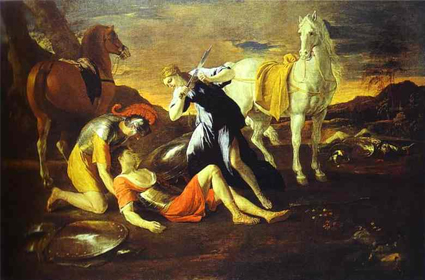The exhibition ''Tancred and Erminia'', is not about Tancred and Erminia at all, argues Andrew Graham-Dixon. It is about second thoughts and about how one of the great artists reinvented himself. The show, at Birmingham City Museum and Art Gallery, brings together two Poussin paintings of a single subject and finds, in the gap between them, the moment when he decided to give up being one kind of artist and become another.
To those who haven't read the Renaissance poet Tasso, Poussin's two paintings of Tancred and Erminia may seem initially mystifying. Who exactly is that bloke lying on the ground, and what's the matter with him? Who is the girl in blue and why is she trying to give herself a haircut with a blunt sword? Thoughtfully, the catalogue gives you the potted version of Poussin's source, Canto XIX of Tasso's verse epic Jerusalem Delivered, which certainly takes some potting.
The story so far: Erminia, a Saracen princess, has fallen secretly in love with Tancred, a Christian knight crusading in foreign lands, despite having accidentally killed her best friend, the Amazon Clorinda (with whom he was secretly in love). Meanwhile Tancred goes into combat with the pagan giant, Argantes, slays him but is severely wounded and collapses on the battlefield next to the body of his victim. Erminia goes in search of Tancred accompanied by his trusty squire Vafrino and, finding him close to death, confesses her love for him and attempts to bind his wounds using her hair as a makeshift bandage.
Poussin knew how to cut a long story short. His first version of Tancred and Erminia, loaned to Birmingham from the Hermitage in St Petersburg, condenses several hundred lines of poetry into a single image tense with emotional conflict. Erminia, suspended between desire...

Painting over the past
03-11-1992

